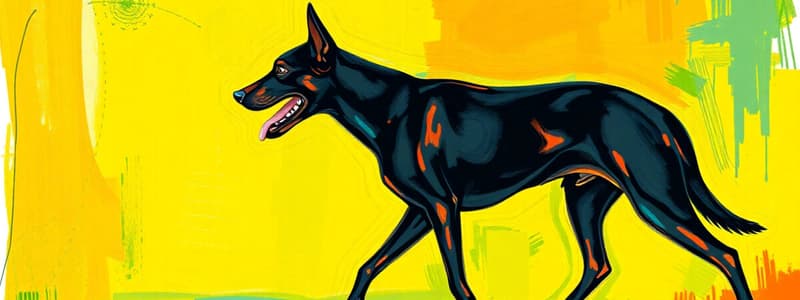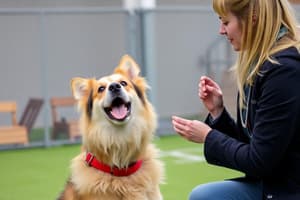Podcast
Questions and Answers
What is the primary goal of dog training?
What is the primary goal of dog training?
- To physically dominate a dog.
- To exclusively use treats to control a dog's actions.
- To teach dogs to perform specific behaviors or commands. (correct)
- To ignore a dog's natural instincts.
Which of the following is a crucial element in effective dog training?
Which of the following is a crucial element in effective dog training?
- Patience (correct)
- Punishment
- Force
- Inconsistency
What is the purpose of positive reinforcement in dog training?
What is the purpose of positive reinforcement in dog training?
- To punish unwanted behavior.
- To create fear in the dog.
- To ignore a dog's actions.
- To increase the likelihood of desired behaviors. (correct)
What is classical conditioning in the context of dog training?
What is classical conditioning in the context of dog training?
Why should punishment be used cautiously in dog training?
Why should punishment be used cautiously in dog training?
What is lure-reward training?
What is lure-reward training?
What is the purpose of using a clicker in clicker training?
What is the purpose of using a clicker in clicker training?
Which of the following describes socialization in puppies?
Which of the following describes socialization in puppies?
What is the first step in addressing problem behaviors in dogs?
What is the first step in addressing problem behaviors in dogs?
Why is it important to avoid punishment during housetraining?
Why is it important to avoid punishment during housetraining?
What should a crate NOT be used for?
What should a crate NOT be used for?
What does the "leave it" command teach a dog?
What does the "leave it" command teach a dog?
What is the main focus of agility training?
What is the main focus of agility training?
What is a common mistake in dog training?
What is a common mistake in dog training?
What should ethical dog training prioritize?
What should ethical dog training prioritize?
According to the content, what does 'extinction' mean in dog training?
According to the content, what does 'extinction' mean in dog training?
In operant conditioning, what shapes behavior?
In operant conditioning, what shapes behavior?
Which of the following is an example of an essential command?
Which of the following is an example of an essential command?
In leash training, what should you use to reward loose-leash walking?
In leash training, what should you use to reward loose-leash walking?
Which dog sport involves a team of dogs racing over hurdles to retrieve a ball from a box?
Which dog sport involves a team of dogs racing over hurdles to retrieve a ball from a box?
Flashcards
Positive Reinforcement
Positive Reinforcement
Rewarding desired actions to make them more likely to happen again.
Classical Conditioning
Classical Conditioning
Pairing a neutral signal with something meaningful to create a learned response.
Operant Conditioning
Operant Conditioning
Learning through the consequences of actions using rewards and punishments.
Punishment
Punishment
Signup and view all the flashcards
Extinction
Extinction
Signup and view all the flashcards
Lure-Reward Training
Lure-Reward Training
Signup and view all the flashcards
Clicker Training
Clicker Training
Signup and view all the flashcards
Shaping
Shaping
Signup and view all the flashcards
Sit
Sit
Signup and view all the flashcards
Stay
Stay
Signup and view all the flashcards
Come
Come
Signup and view all the flashcards
Down
Down
Signup and view all the flashcards
Heel
Heel
Signup and view all the flashcards
Leave It
Leave It
Signup and view all the flashcards
Socialization
Socialization
Signup and view all the flashcards
Crate Training
Crate Training
Signup and view all the flashcards
Agility Training
Agility Training
Signup and view all the flashcards
Obedience Training
Obedience Training
Signup and view all the flashcards
Rally
Rally
Signup and view all the flashcards
Scent Work
Scent Work
Signup and view all the flashcards
Study Notes
- Dog training encompasses teaching a dog to perform specific behaviors or commands, as well as modifying unwanted behaviors.
- Effective dog training relies on understanding canine behavior, learning styles, and communication methods.
- Consistency, patience, and positive reinforcement are crucial elements.
Basic Principles
- Positive Reinforcement: Rewarding desired behaviors to increase their likelihood. Can include treats, praise, toys, or affection.
- Classical Conditioning: Associating a neutral stimulus with a meaningful one to create a conditioned response (e.g., clicker training).
- Operant Conditioning: Learning through consequences, using reinforcement and punishment to shape behavior.
- Punishment: Aims to decrease unwanted behaviors, but should be used cautiously to avoid fear, anxiety, and aggression.
- Extinction: Withholding reinforcement for a previously reinforced behavior to decrease its occurrence.
Training Methods
- Lure-Reward Training: Using a treat or toy to guide the dog into the desired position or behavior.
- Clicker Training: Using a clicker to mark the exact moment a dog performs the desired behavior, followed by a reward.
- Shaping: Rewarding successive approximations of the desired behavior until the full behavior is achieved.
- Modeling: Having another dog or person demonstrate the desired behavior.
- Negative Punishment (removal of something good) and Negative Reinforcement (removal of something bad)
Essential Commands
- Sit: Teaching the dog to lower its hindquarters to the ground.
- Stay: Teaching the dog to remain in a specific position (sit, down, stand) until released.
- Come: Teaching the dog to return to the handler when called.
- Down: Teaching the dog to lie down on the ground.
- Heel: Teaching the dog to walk politely beside the handler without pulling on the leash.
- Leave It: Teaching the dog to ignore or leave something that it is interested in.
Socialization
- Exposing puppies to a variety of people, dogs, environments, and experiences during their critical socialization period (typically up to 16 weeks of age).
- Helps prevent fear, anxiety, and aggression later in life.
- Controlled and positive interactions are key to successful socialization.
Addressing Problem Behaviors
- Common problem behaviors: excessive barking, chewing, digging, jumping, separation anxiety, aggression.
- Identifying the underlying cause of the behavior is essential for effective modification.
- Management techniques (e.g., crate training, environmental modifications) can help prevent problem behaviors.
- Behavior modification techniques (e.g., desensitization, counter-conditioning) can help change the dog's emotional response to triggers.
- Consulting with a certified professional dog trainer or veterinary behaviorist is recommended for serious behavior problems.
Leash Training
- Start with a comfortable collar or harness and a lightweight leash.
- Teach the dog to walk politely on a leash without pulling.
- Use positive reinforcement to reward loose-leash walking.
- Change direction frequently to keep the dog engaged.
- Avoid punishment, which can create negative associations with leash walking.
Crate Training
- Introducing the crate as a safe and comfortable den for the dog.
- Gradually acclimate the dog to the crate, using positive reinforcement.
- Never use the crate as punishment.
- Crate training can help with housetraining, prevent destructive behaviors, and provide a sense of security for the dog.
Housetraining
- Establishing a regular potty schedule.
- Taking the puppy outside frequently, especially after waking up, eating, and playing.
- Rewarding the puppy immediately after it eliminates outside.
- Cleaning up accidents thoroughly to eliminate odors.
- Avoiding punishment for accidents, which can create fear and anxiety.
Training Tools
- Leashes: Standard leashes, retractable leashes (use with caution), long lines.
- Collars: Flat collars, martingale collars, prong collars (use with caution and proper training).
- Harnesses: Front-clip harnesses, back-clip harnesses.
- Training Treats: Small, soft, and highly palatable treats.
- Clickers: Used for clicker training.
- Toys: Used as rewards and for engagement.
Advanced Training
- Agility Training: Navigating an obstacle course with speed and accuracy.
- Obedience Training: Performing advanced obedience exercises with precision.
- Trick Training: Teaching the dog a variety of fun and impressive tricks.
- Scent Work: Training the dog to locate specific odors.
- Therapy Dog Training: Preparing the dog to provide comfort and support to people in need.
Dog Sports
- Agility: Dogs navigate an obstacle course against the clock.
- Obedience: Dogs perform a series of exercises to demonstrate their training and obedience.
- Rally: A combination of obedience and agility, where dogs follow a course of signs with instructions.
- Dock Diving: Dogs jump for distance or height into a pool of water.
- Flyball: A team sport where dogs race over hurdles to retrieve a ball from a box.
Common Mistakes
- Inconsistency: Not enforcing the same rules and commands consistently.
- Lack of Patience: Getting frustrated and giving up too easily.
- Using Punishment Too Often: Relying on punishment instead of positive reinforcement.
- Confusing Signals: Giving the dog conflicting or unclear signals.
- Not Generalizing Training: Failing to practice in different environments and situations.
- Infrequent or inconsistent reinforcement
Key Considerations
- Breed Characteristics: Different breeds have different predispositions and temperaments.
- Age and Development: Puppies require different training approaches than adult dogs.
- Individual Personality: Each dog has its own unique personality and learning style.
- Health Conditions: Certain health conditions can affect a dog's ability to learn and perform.
- Environmental Factors: The training environment can influence a dog's behavior and focus.
- Diet: Impact on energy levels and overall health, influencing trainability.
Resources
- Certified Professional Dog Trainers (CPDTs).
- Veterinary Behaviorists.
- Dog Training Books and Websites.
- Dog Training Classes and Workshops.
- Local Dog Training Clubs.
Ethical Considerations
- Using humane and ethical training methods.
- Avoiding the use of force, fear, or intimidation.
- Prioritizing the dog's physical and emotional well-being.
- Being responsible and considerate pet owners.
- Continuously learning and improving training skills.
Studying That Suits You
Use AI to generate personalized quizzes and flashcards to suit your learning preferences.




